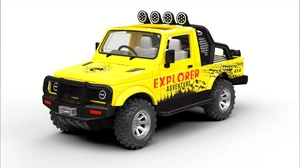Remote toy cars, also known as remote-controlled (RC) cars, are miniature vehicles powered by electric motors, nitro engines, or gas engines and controlled using a remote.
Electric RC Cars:
- Powered by rechargeable batteries.
- Quiet operation and low maintenance.
- Ideal for beginners.
Off-Road RC Cars:
- Designed for rough terrains like dirt, grass, and sand.
- Features large tires and durable suspension.
RC Trucks and Buggies:
- Trucks are rugged and suitable for extreme terrains.
- Buggies balance speed and off-road capability.
Remote toy cars, also known as remote-controlled (RC) cars, are miniature vehicles powered by electric motors, nitro engines, or gas engines and controlled using a remote. These toys are popular among hobbyists and kids for their versatility, speed, and customizability.
Types of Remote Toy Cars:
-
Electric RC Cars:
- Powered by rechargeable batteries.
- Quiet operation and low maintenance.
- Ideal for beginners.
-
Nitro RC Cars:
- Powered by nitro-methane fuel.
- Faster and more powerful than electric cars.
- Requires maintenance and is suitable for enthusiasts.
-
Gasoline RC Cars:
- Run on regular gasoline mixed with oil.
- High power and long run times.
- More suited for advanced users.
-
Off-Road RC Cars:
- Designed for rough terrains like dirt, grass, and sand.
- Features large tires and durable suspension.
-
On-Road RC Cars:
- Built for smooth surfaces like roads or tracks.
- Focused on speed and precision handling.
-
RC Trucks and Buggies:
- Trucks are rugged and suitable for extreme terrains.
- Buggies balance speed and off-road capability.
-
RC Crawlers:
- Specialized for climbing rocks and navigating challenging terrain.
- Slow but highly durable and precise.
Key Features to Consider:
- Control Range: The distance the remote can effectively control the car.
- Speed: Some RC cars can reach speeds
- Durability: Look for materials like metal chassis and shock-absorbing suspension.
- Battery Life: Longer battery life means extended playtime.
- Scale Size: Ranges from small (1:32)


